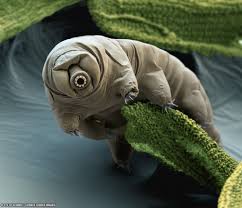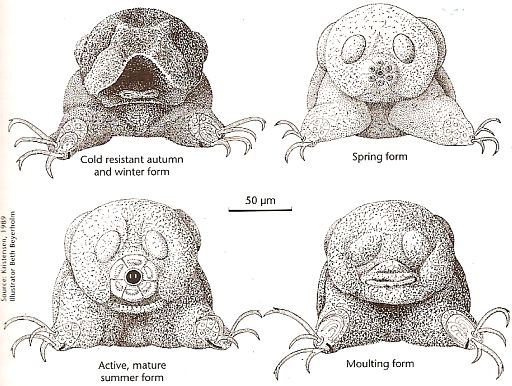Continuing our series on the cutest invertebrates you didn’t know existed.
Dear Biology Nerd,
I heard something about a “water bear” and I want to see them, but I think they’re microscopic. What are they and are they as cuddly as they sound?
-Katie Mascia
***
Dear Katie,
“Water bears” are easily some of the cutest things that I encountered in freshman biology. They are major representatives of the phylum of invertebrate animals, the Tardigrada.1 Also, they are known by another nickname besides “water bears” … “moss piglets.”2 How could they not be adorable?

I call him “Wilbur” and that is “some pig.”
(Photo credit: http://apod.nasa.gov/apod/ap130306.html)
They’re cute, plump fellows that are found just about everywhere there’s even a droplet of water. They are tiny — the little guy in the picture above is 1 mm long and that is a colorized electron micrograph.3 They can survive without water by drying themselves out and hibernating, but in order to be active they require a coating of liquid so that they can exchange oxygen and carbon dioxide with the environment.
Scientists call them “water bears” because of their roly-poly bellies and because all of their eight legs end in 4-8 claws.1 The “moss piglets” presumably comes (I’m guessing at etymology here) from the fact that they commonly live in the water droplets on moss, like you find in any back yard, and from those “noses.”
These guys have been identified by NASA as being the most likely creatures on Earth to be aliens. They think this because the tiny, tiny critters are almost impossible to kill. They can survive for DECADES without food or water, at temperatures near absolute zero (which for you non-sciencey Europeans is -273 degrees Celsius, or −459.67 Fahrenheit for non-sciencey Americans; ice forms at 0 degrees C and 32 degrees F). They can survive at the most extreme pressures Earth has to offer, from the tops of mountains to the bottom of ocean. Also, because NASA is full of scientists after my own heart, in 2011 they threw a pile of water bears outside of a space shuttle in OUTER SPACE and the suckers still survived!
Alright, NASA admits they probably aren’t aliens, but they could be! They survive high levels of radiation. It isn’t hard to imagine them floating on a loose space rock and careening into Earth and conquering it with their tiny, adorable little selves. In fact, they are more common than humans on most of the Earth.3
Also, they look different based on the environmental conditions. And clearly showcasing that variety is the main reason for this picture, not just to show you their cute little faces!4

ADORBS.
(Photo credit: http://bogleech.com/nature/tardi-face.jpg)
So yes, Katie, they are absolutely adorable, virtually indestructible, possibly alien creatures that are visible under your standard light microscope. Watch them swim on the youtube!
Biology Nerd, away!
Got a biology question? Ask the Biology Nerd! asktheleagueofnerds@gmail.com
Or: Twitter @AskTheLeague / facebook.com/asktheleagueofnerds
1. http://sun.iwu.edu/~tardisdp/tardigrade_facts.html
2. http://www.newscientist.com/article/mg16422095.100-indestructible.html
3. http://apod.nasa.gov/apod/ap130306.html
4. http://bogleech.com/nature/tardi-face.jpg
A NOTE: Hey, this is the League of Nerds one-year anniversary! HAPPY BIRTHDAY TO US! Thanks for sticking with us for our first year, and hope to see you for many more!